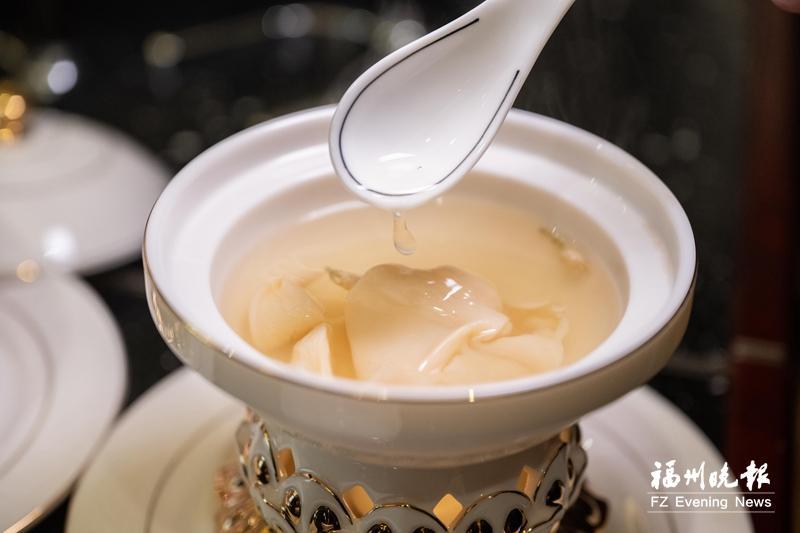Changle Cuisine Facilitates Fuzhou’s Bid for “City of Gastronomy”
Fuzhou is bidding for “City of Gastronomy” now.
Changle District, known for its stunning landscapes and rich historical and cultural heritage, is also famous for its diverse and renowned local cuisine, which contributes to Fuzhou’s bid for the “City of Gastronomy.” Now, with the arrival of spring, visitors to Changle can not only enjoy the beautiful scenery but also savor a wide variety of delicious food.

Instant-boiled Sea Clam in Chicken Broth (File Photo)
“Pearl of Fujian Cuisine” comes from Changle
As a shining pearl of Fujian cuisine and Fuzhou cuisine, Instant-boiled Sea Clam in Chicken Broth is renowned for its exceptional taste. The clams featured in this dish are the Zhanggang sea clams, harvested from the waters of Changle.
Zhanggang sea clams, also called “Xishishe” in Chinese, are a rare and valuable variety of shellfish unique to Changle District. Known for their tender meat and sweet flavor, these clams became a court delicacy as early as the Ming Dynasty and have since gained fame both domestically and internationally.
In the early 1980s, Fujian cuisine masters Qiang Mugen and Qiang Ququ created the exquisite dish “Instant-boiled Sea Clam in Chicken Broth,” further boosting the fame of Zhanggang sea clams.
In 1994, Zhanggang sea clams were recognized as a notable, special, high-quality and new agricultural product in Fujian. In 2001, they were honored with the title of “Fujian Famous Agricultural Product” by the People's Government of Fujian Province. In 2010, they were recognized as a national geographical indication product.
The Changle Sea Clam Resource Proliferation Protection Area was established in 1985. It is currently the only conservation area in China dedicated to safeguarding the Zhanggang sea clam population. Over the past 40 years, it has provided a strong safeguard for the survival and reproduction of these clams.
On January 18, the first flagship store specializing in Zhanggang sea clams opened on Heping Street in Changle.
A variety of foods receive national certification
Changle District currently holds four geographical indication certification trademarks: Zhanggang sea clams, Qingshan longan, Changle sweet potatoes, and Shibi white radish. It also has one geographical indication product -- Zhanggang sea clams. As a local specialty, Zhanggang sea clams are both a geographical indication certification trademark and a geographical indication product.
Qingshan longan is famously known as the “Millennium Tribute Fruit.” According to historical records, in the second year of the Shaoxi era during the Southern Song Dynasty, Huang Mianzhai, the son-in-law of Zhu Xi, presented Qingshan longans from his hometown to Emperor Guangzong. After sampling the fruit, the emperor praised it highly, officially designating it as a tribute and conferring the honorary plaque “Huanglong.”
Chen Zhenlong, a native of Qingqiao Village in Changle during the Ming Dynasty, was celebrated as the “Father of Sweet Potatoes.” According to legend, he passed the county-level imperial examination before the age of 20 but failed the provincial exam. Disappointed, he abandoned his academic ambitions and turned to business, eventually relocating to Luzon Island (now the Philippines) to engage in trade. There, he discovered a variety of purple sweet potatoes that were drought-resistant, easy to grow, and edible both raw and cooked. It was said to have “six benefits and eight advantages, providing the same nourishment as the five grains.”
In May of the 21st year of the Wanli era in the Ming Dynasty, Chen Zhenlong brought sweet potato vines back to Fuzhou for cultivation. Later, Jin Xuezeng, then Governor of Fujian, attempted to grow the purple sweet potato to alleviate famine, effectively addressing the food shortage in Fujian. Today, Changle extensively grows sweet potatoes, transforming them into a variety of culinary delights.
“New” dishes are widely favored
Changle District is home to a diverse array of traditional Fuzhou snacks, including fish balls, pork wonton, taro paste, pot edge paste, taro cakes, layered cakes, sesame cakes, Fuzhou meat floss, scallion oil cakes, wonton wrappers, thin noodles, spring rolls, fish dumplings, and Zhanggang fish noodles, among others. In recent years, Changle ice rice has gained widespread popularity both domestically and overseas for its refreshing and sweet taste.
Changle ice rice originated in the 1980s in Changle District, evolving from the traditional summer drink “ice water.” Today, it has become a popular summer dessert in Fuzhou. It is made by mixing glutinous rice with a small amount of sugar and butter, then allowing it to cool. Once cooled, it is combined with homemade ice water, crushed ice, taro balls, coconut jelly, and other ingredients, creating a refreshing treat.
Additionally, Changle’s Guhuai meat stuffed buns are notably famous. Originating from Guhuai Town in Changle, they are a type of roasted meat buns. The dough is made from fermented flour, and the filling primarily consists of fresh meat, minced and seasoned with five-spice powder, dried shrimp, chopped scallions, salt, and MSG. Once the buns are shaped, sesame seeds are evenly sprinkled on top, and they are then pressed against the walls of a furnace to bake to perfection. (Fuzhou Evening News Reporter: Xu Wenyu/Text, Lin Shuangwei/Photo)